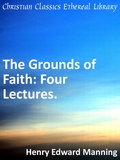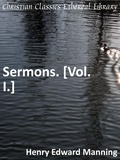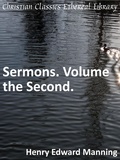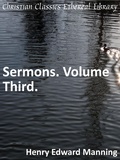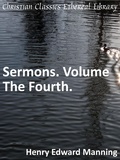Henry Edward Manning
English Roman Catholic Archbishop of Westminster and a cardinal
Biography
Manning was born at Totteridge, Hertfordshire, the third and youngest son of William Manning, a West India merchant, who served as a director and (1812–1813) as a governor of the Bank of England and also sat in Parliament for 30 years, representing in the Tory interest Plympton Earle, Lymington, Evesham and Penryn consecutively. Manning's mother, Mary (died 1847), daughter of Henry Leroy Hunter, of Beech Hill, and sister of Sir Claudius Stephen Hunter, 1st Baronet, came of a family said to be of French extraction.
Manning spent his boyhood mainly at Coombe Bank, Sundridge, Kent, where he had for companions Charles Wordsworth and Christopher Wordsworth, later bishops of St Andrews and Lincoln respectively. He attended Harrow School (1822–1827) during the headmastership of Dr George Butler, but obtained no distinction beyond playing in the cricket eleven in 1825. However, this proved to be no impediment to his academic career.
Manning matriculated at Balliol College, Oxford in 1827 and soon made his mark as a debater at the Oxford Union, where William Ewart Gladstone succeeded him as president in 1830. At this date he had ambitions of a political career, but his father had sustained severe losses in business and, in these circumstances, having graduated with first-class honours in 1830, he obtained the year following, through Frederick John Robinson, 1st Viscount Goderich, a post as a supernumerary clerk in the Colonial Office.
Manning resigned from this position in 1832, his thoughts having turned towards a clerical career under Evangelical influences, including his friendship with Favell Lee Mortimer, which affected him deeply throughout life.
Returning to Oxford in 1832, he gained election as a fellow of Merton College and received ordination as a deacon in the Church of England. In January 1833 he became curate to John Sargent, Rector of Lavington-with-Graffham, Sussex, and in May succeeded him as rector due to the patronage of Mrs. Sargent, mother of the late rector.
Manning married Caroline, John Sargent's daughter, on 7 November 1833, in a ceremony performed by the bride's brother-in-law, The Rev. Samuel Wilberforce, later Bishop of Oxford and Winchester. Manning's marriage did not last long: his young and beautiful wife came of a consumptive family and died childless on 24 July 1837. When Manning died many years later, for decades a celibate Roman Catholic clergyman, a locket containing his wife's picture was found on a chain around his neck.
Though he never became an acknowledged disciple of John Henry Newman (later Cardinal Newman), the latter's influence meant that from this date Manning's theology assumed an increasingly High Church character and his printed sermon on the "Rule of Faith" publicly signalled his alliance with the Tractarians.
In 1838 he took a leading part in the church education movement, by which diocesan boards were established throughout the country; and he wrote an open letter to his bishop in criticism of the recent appointment of the ecclesiastical commission. In December of that year he paid his first visit to Rome and called on Dr Wiseman in company with Gladstone.
In January 1841, Philip Shuttleworth, Bishop of Chichester, appointed him Archdeacon of Chichester, whereupon he began a personal visitation of each parish within his district, completing the task in 1843. In 1842 he published a treatise on The Unity of the Church and his reputation as an eloquent and earnest preacher being by this time considerable, he was in the same year appointed select preacher by his university, thus being called upon to fill from time to time the pulpit which Newman, as vicar of St Mary's, was just ceasing to occupy.
Four volumes of Manning's sermons appeared between the years 1842 and 1850, and these had reached the 7th, 4th, 3rd and 2nd editions respectively in 1850, but were not afterwards reprinted. In 1844 his portrait was painted by George Richmond, and the same year he published a volume of university sermons, omitting the one on the Gunpowder Plot. This sermon had annoyed Newman and his more advanced disciples, but it was a proof that at that date Manning was loyal to the Church of England as a Protestant.
Newman's secession in 1845 placed Manning in a position of greater responsibility, as one of the High Church leaders, along with Edward Bouverie Pusey, John Keble and Marriott; but it was with Gladstone and James Robert Hope-Scott that he was at this time most closely associated.
Manning's belief in Anglicanism was shattered in 1850, when, in the so-called Gorham judgement, the Privy Council successfully ordered the Church to institute an Evangelical clergyman who denied that the sacrament of baptism had an objective effect of baptismal regeneration. The denial of the objective effect of the sacraments was to Manning and many others a grave heresy, contradicting the clear tradition of the Christian Church from the Fathers of the Church on, and the fact that a civil, secular court had the power to force the Anglican Church to accept such a heretical opinion proved to him that, far from being a divinely created institution, the Anglican church was merely a man-made creation of the English Parliament.
The following year, on 6 April 1851, he was received into the Catholic Church and soon after, on 14 June 1851 was ordained a priest in it. Given his great abilities and prior fame, he quickly rose to a position of influence, and, in 1865, was chosen as Archbishop of Westminster. He was now styled His Grace The Most Rev. Dr. Henry Edward Manning, Lord Archbishop of Westminster.
Among his accomplishments as head of the Catholic Church in England were the building of Westminster Cathedral and a greatly expanded system of Roman Catholic education, including the establishment of the short lived Catholic University College in Kensington. In 1875, Manning was created Cardinal-Priest of Ss. Andrea e Gregorio al Monte Celio. He now become His Eminence The Most Rev. Dr. Henry Edward Cardinal Manning, Lord Archbishop of Westminster. Cardinal Manning participated in the conclave that elected Pope Leo XIII in 1878.
He also approved the founding of the Catholic Association Pilgrimage.
Cardinal Manning was very influential in setting the direction of the modern Catholic Church. His warm relations with Pope Leo XIII and his ultramontane views gained him the trust of the Vatican. He was among the strongest supporters of the doctrine of papal infallibility, unlike Cardinal Newman, who believed the doctrine but thought it might not be prudent to formally define it at the time. Manning used this goodwill to promote a modern Roman Catholic view of social justice. These views are reflected in the papal encyclical Rerum Novarum issued by Leo XIII. It is the beginning of modern Roman Catholic social justice teaching.
Cardinal Manning was instrumental in settling the London Dock Strike of 1889. He had a significant role in the conversion of notable figures, including Elizabeth Belloc, the mother of the famous British author, Hilaire Belloc, upon whose thinking Manning had a profound influence.
When Cardinal Manning died his estate was probated at £3,527. His funeral was the largest seen in Victorian London.
-- Wikipedia